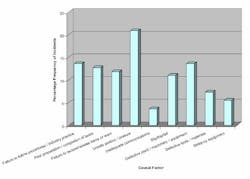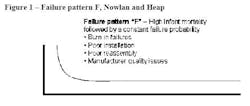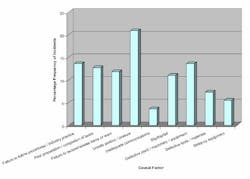Human error used to be an area that was only associated with high-risk industries like aviation, rail, petrochemical and the nuclear industry. The high consequences of fail-ure in these industries meant that there was a real obligation on companies to try to reduce the likelihood of all failure causes, not just those related to “normal” or engi-neering failures.
However, there is a lot to be gained, for relatively little outlay, by including a focus on human error within all maintenance operations. This is not new. The original RCM report by Nowlan and Heap informed us that human error was a large contributing factor to asset failure. One of the failure patterns they defined, pattern “F,” points to the impact of human error.
There are various causes of high infant mortality failures in asset maintenance, and it is worth noting that in the original RCM report this failure pattern made up for 64% of all failure types. While it does not indicate exactly what percentage of these were tracked back to human errors, it seems reasonable to assume that it is a significant contributor.
So what does this tell us? And of what use is it to the operation of your plant today?
I think it tells us a lot. Human error continues to be a common cause of asset failure, both in terms of how an asset is maintained, as well as how it is operated. We see this all the time in areas such as poor calibration, poor alignment, incorrect settings, and even poor quality workmanship.
It also tells us that the best way to avoid the likelihood of human error is to make sure that we only perform pervasive maintenance when there is no other option. However, for those tasks that we have to carry out, how can we reduce the likelihood of a hu-man error related failure?
If you look at the conditions involved in asset maintenance, there are a multitude of reasons why human error would occur which include frequent removal and replace-ment of large numbers of varied components, often carried out in cramped and poorly lit spaces with less-than-adequate tools, and usually under severe time pressure.
In fact, in a study of data from 2001 onwards, the Health and Safety Executive of the UK states that more than 60% of all maintenance failures had human error at the root cause, with only 21% representing true engineering failures.
Equipment alignment is a prime example. Fixing a motor to a new plinth and then aligning it to whatever it is driving is a pretty standard task. Yet there are a large number of ways we can make mistakes. Poorly marking the footing mounts, poor drilling (too shallow, not in line) and poor alignment practices are all valid examples.
Also, after a few months new concrete plinths have a tendency to “settle,” often forc-ing misalignment through shifting of the motor. Failure to take this into account and to perform the necessary checks to correct it if it occurs, is also a human error related issue.
How can we avoid all of the danger areas associated with this task? Many companies often issue work procedures to help them to minimize mistakes such as these. Sounds logical, right? I have done this myself.
You’ll be surprised to learn that the work procedure helps to increase the likelihood of error, not reduce it.
You’re probably asking: How could a procedure, with all of the correct steps in it, make things worse?
It all depends on the job procedure, and on how it is written, but is a range of things that can be done easily to reduce the possibility of mistakes.
(Some of the examples below are from my own observations; others come from James Reasons excellent book “Managing the Risks of Organizational Accidents.)
For example:
- Very wordy sentences and instructions will often be ignored. This is human na-ture. Make sure that the instructions are broken into logical parts, and that they are written in short concise sentences in layman’s terms.
- Studies have shown that when there is a long list of instructions, those in the mid-dle will often be omitted. Make a quality assurance check at the end and ask the technician to double check whether they did certain frequently omitted tasks.
- Too many instructions will be ignored, as will too few. Procedures need to be aimed at presenting an accurate level of detail and instruction as is required.
- A lot of work instructions are focused on the present, but often there is a need for a re-check of alignment several months afterwards. Employ this in the work pro-cedure; make it a task for the maintenance scheduler or to program a separate task once this task has been done.
- More than all of the above, procedures must not tell technicians how to perform basic skills, or they will be ignored. (E.g. don’t go into detail about how to torque a bolt or remove a screw.)
Procedures is one of the many areas where slight adjustments in current practice could have a big impact in reducing lost time and money due to human error. There are many others. There are a range of formal methods that may be of use to you. I prefer a method called Human Error Assessment and Reduction Technique or HEART. This is a straight forward, practical and rapid method that will allow you to perform regular and focussed risk analyses of tasks.
As reliability methods become more accurate, and the science of physical asset reli-ability becomes more widespread, human error is one of the remaining areas where significant gains can be made quickly. No longer restricted to the areas of safety and the environment, human error is now helping many companies to reduce costs and increase productivity.


